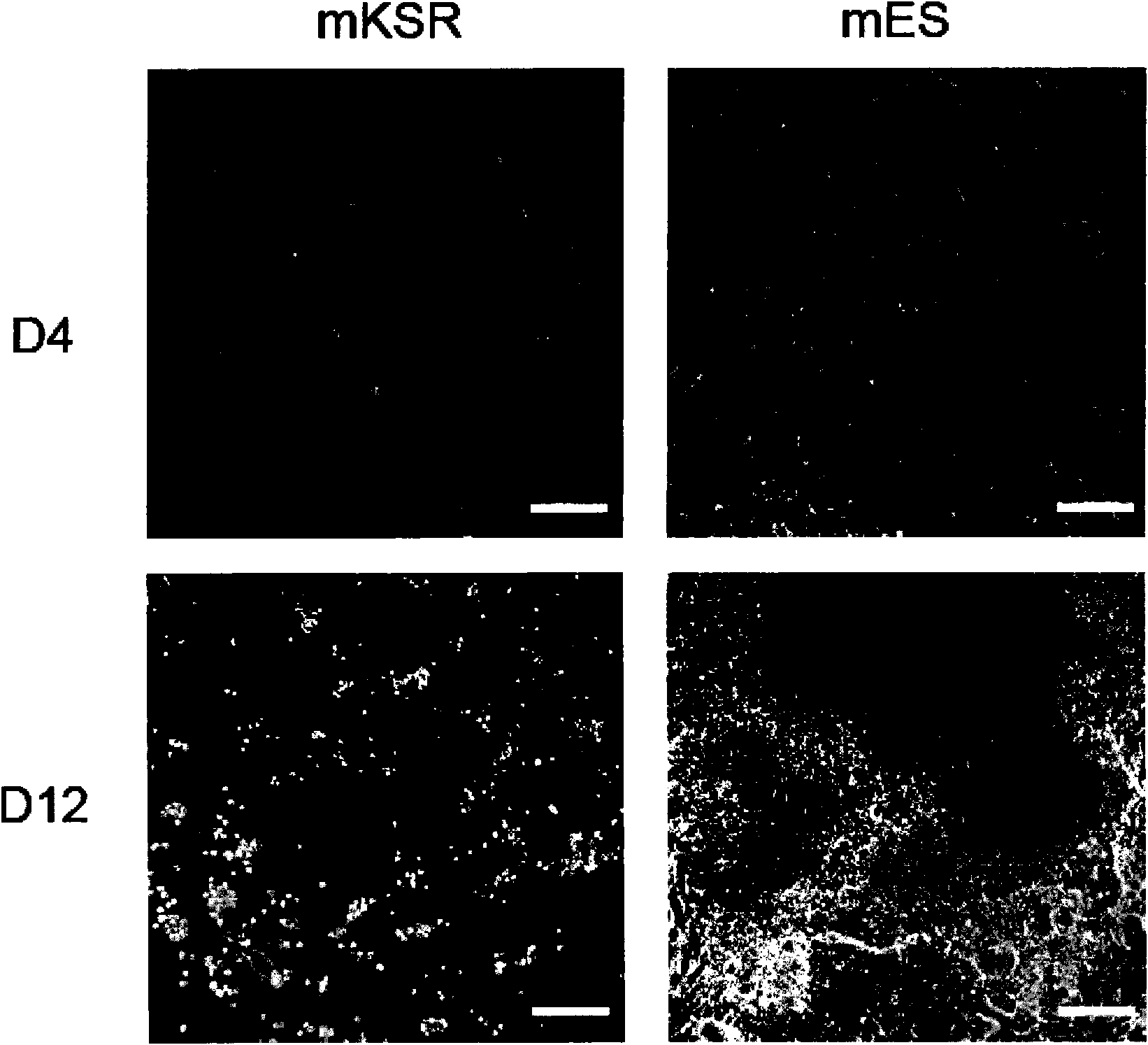Novel serum-free culture medium for inducing fast and efficient production of pluripotent stem cells and use method thereof
A technology of pluripotent stem cells and serum-free medium, applied in artificially induced pluripotent cells, cell culture active agents, biochemical equipment and methods, etc., can solve problems such as inability to support iPS proliferation and formation
- Summary
- Abstract
- Description
- Claims
- Application Information
AI Technical Summary
Problems solved by technology
Method used
Image
Examples
Embodiment 1
[0082] Example 1: The traditional mKSR medium cannot maintain the growth of MEFs transfected with 4 factors, and cannot induce the formation of iPS at the same time
[0083] As mentioned before, the four-factor virus was mixed 1:1:1:1 (each 1ml) and infected into a total of 35,000 fibroblasts in one well of a six-well plate, and at 37 degrees, 5% CO 2 Cultured in mKSR and mES medium, respectively.
[0084] like figure 1 As shown, the growth of fibroblasts transfected with 4 factors cultured in mKSR was retarded, and the cell colony morphology of pluripotent cells still did not form at 12 days, that is, the mKSR medium could not induce and produce iPS colonies.
Embodiment 2
[0085] Example 2: The application of iPS-SF1 medium can greatly improve the efficiency of iPS induction
[0086] A. The growth curves of MEFs cultured in FBS and iPS-SF1 medium were almost the same, indicating that iPS-SF1 had no effect on the culture of MEFs. In contrast, the growth of MEFs basically stopped in mKSR. (Figure 2A)
[0087] After transfecting fibroblasts with 3 factors (Oct4, Klf4 and Sox2) or 4 factors (cMyc, Oct4, Klf4 and Sox2), respectively, the transfected cells were cultured in iPS-SF1 medium In 2, 5 and 7 days after transfection, the efficiency of GFP-positive cells was determined as described above, and it was observed that cells transfected with 4 factors or 3 factors showed high efficiency (Fig. 2B ), even reached 18% on the 7th day, which is a very large improvement compared to the traditional method (mES control shown in the figure).
[0088] Correspondingly, in this process, by direct observation with a fluorescence microscope, it can also be foun...
Embodiment 3
[0090] Example 3: iPS-SF1 induced iPS has pluripotency.
[0091] A The induced iPS cell line has a cell morphology similar to that of embryonic stem cells
[0092] As above, fibroblasts were infected with 3 factors, and then cultured in iPS-SF1 medium. On day 12-14 after infection, representative clones were selected according to the clone morphology and fluorescence expression. After several generations of stable passage, a uniform iPS cell line was formed.
[0093] As shown in Figure 2A, the left panel is a normal embryonic stem cell, and the right panel: the above-mentioned iPS cell line. These cell lines are morphologically very similar to embryonic stem cells and strongly express the green fluorescence of Oct4-GFP.
[0094] Formation of B chimeric mice verifies that the induced iPS cell lines are pluripotent
[0095] chimeric mice
[0096] Blastocysts for injection were taken from four-week-old superovulated ICR female mice (white), and housed with male mice of the sa...
PUM
 Login to View More
Login to View More Abstract
Description
Claims
Application Information
 Login to View More
Login to View More - R&D
- Intellectual Property
- Life Sciences
- Materials
- Tech Scout
- Unparalleled Data Quality
- Higher Quality Content
- 60% Fewer Hallucinations
Browse by: Latest US Patents, China's latest patents, Technical Efficacy Thesaurus, Application Domain, Technology Topic, Popular Technical Reports.
© 2025 PatSnap. All rights reserved.Legal|Privacy policy|Modern Slavery Act Transparency Statement|Sitemap|About US| Contact US: help@patsnap.com



